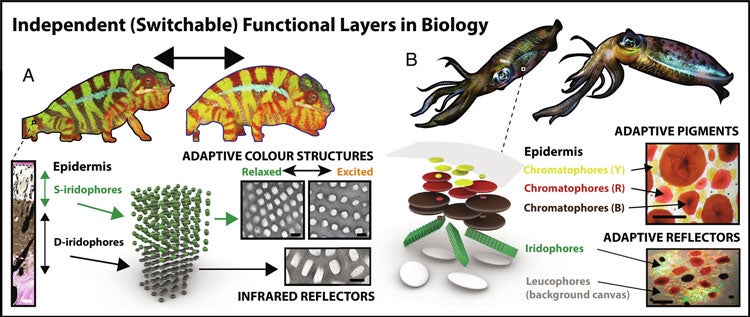
Climate Positive Energy is proud with the early outcomes of its funded project with Professor Ben Hatton and his research team, who have developed a multilayered fluidic system, inspired by the colour-changing skin of organisms such as squids, that can reduce the energy costs of heating, cooling, and lighting buildings.
The platform, which optimizes the wavelength, intensity and dispersion of light transmitted through windows, offers much greater control than existing technologies while keeping costs low due to its use of simple, off-the-shelf components.
“Buildings use a ton of energy to heat, cool and illuminate the spaces inside them,” says Raphael Kay, who recently graduated with a master’s degree in mechanical engineering from the Faculty of Applied Science & Engineering and is lead author on a new paper published in the journal PNAS.
“If we can strategically control the amount, type and direction of solar energy that enters our buildings, we can massively reduce the amount of work that we ask heaters, coolers and lights to do.”
Currently, certain “smart” building technologies such as automatic blinds or electrochromic windows – which change their opacity in response to an electric current – can be used to control the amount of sunlight that enters the room. But Kay says that these systems are limited: they cannot discriminate between different wavelengths of light, nor can they control how that light gets distributed spatially.
“Sunlight contains visible light, which impacts the illumination in the building – but it also contains other invisible wavelengths, such as infrared light, which we can think of essentially as heat,” he says.
“In the middle of the day in winter, you’d probably want to let in both – but in the middle of the day in summer, you’d want to let in just the visible light and not the heat. Current systems typically can’t do this – they either block both or neither. They also have no ability to direct or scatter the light in beneficial ways.”

Biological inspiration for fluidic multilayer: (A) Colour change in the panther chameleon is achieved using a multilayer architecture of active photonic crystals; (B) Colour change in the squid is achieved using co-ordinated actuations within a multilayer of pigmentary and structural elements.
Developed by Kay and a team led by Associate Professor Ben Hatton, the system leverages the power of microfluidics to offer an alternative. The team also included PhD candidate Charlie Katrycz, both in the department of materials science and engineering, and Alstan Jakubiec, an assistant professor in the John H. Daniels Faculty of Architecture, Landscape, and Design.
The work builds on another system that uses injected pigment, developed by the same team earlier this year. While that study drew inspiration from the colour-changing abilities of marine arthropods, the current system is more analogous to the multilayered skin of squid.
Ben Hatton’s research was introduced as “incredible” on CP24 Breakfast, where he was recently featured in a segment. Watch the interview here.
Or, read the full article via U of T News.
Congratulations to Professor Hatton and his research team!